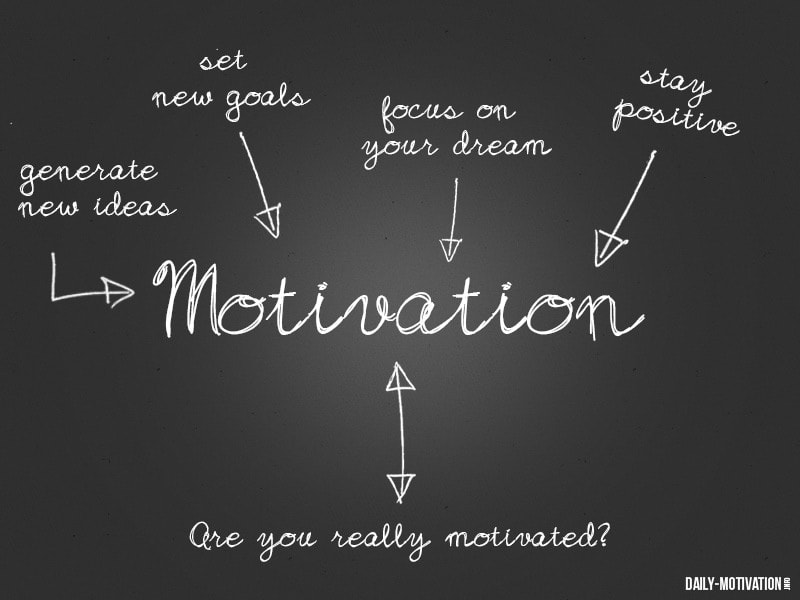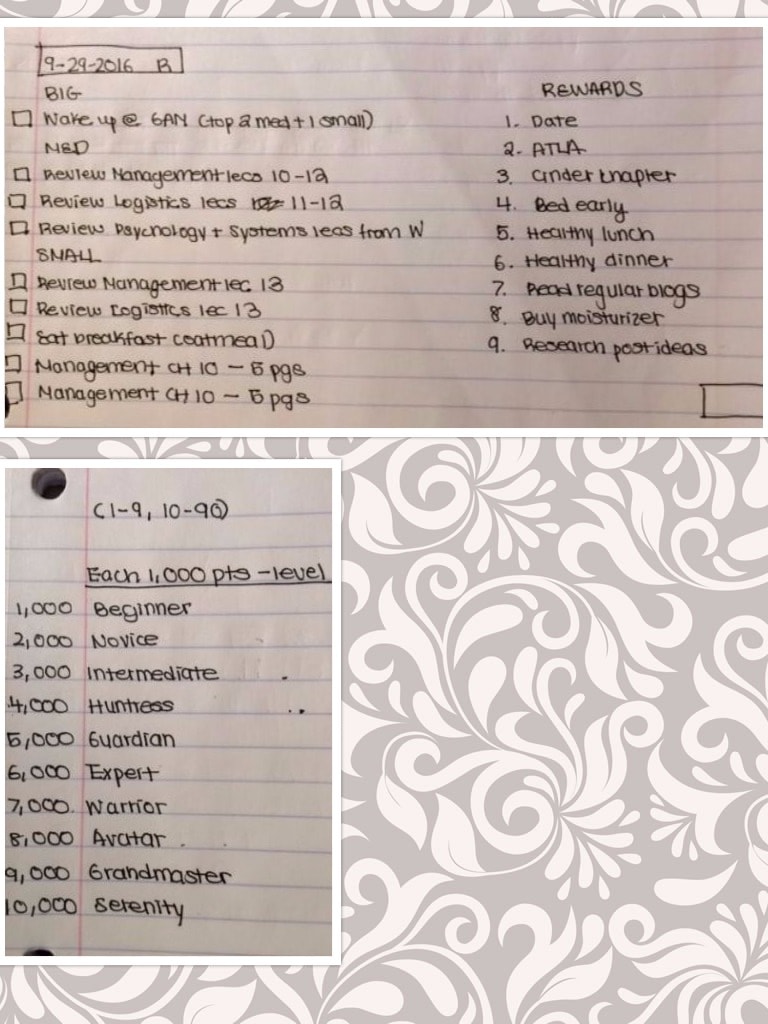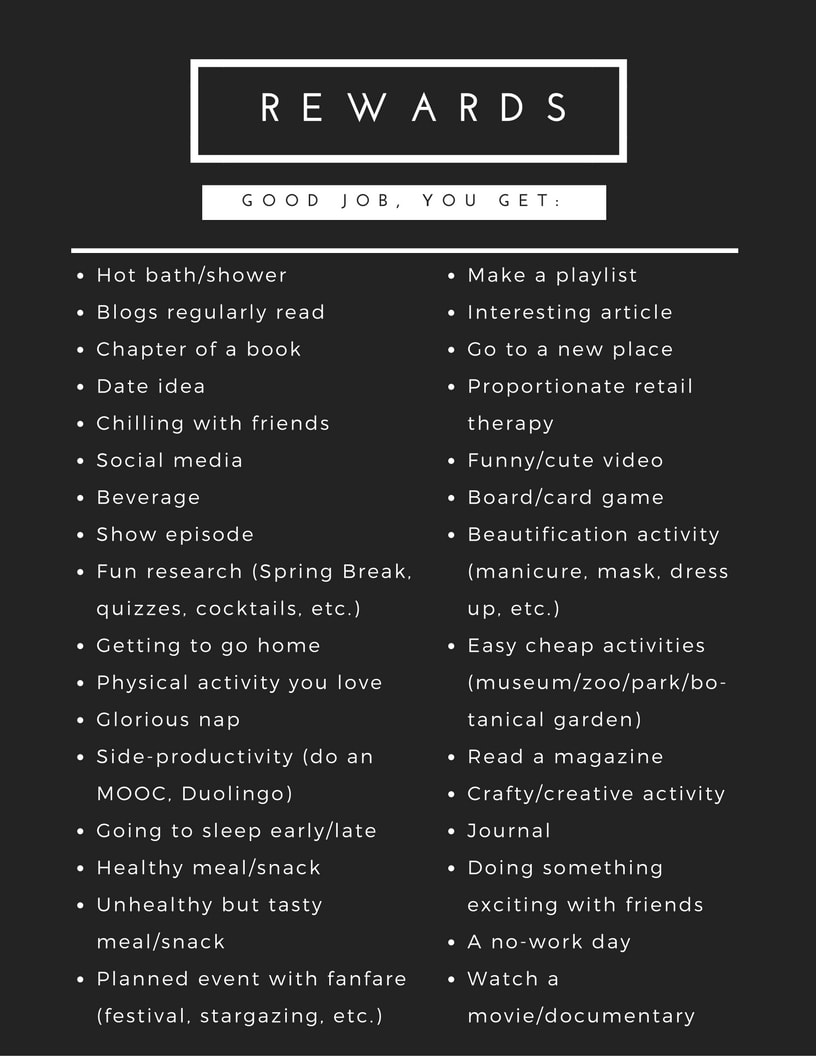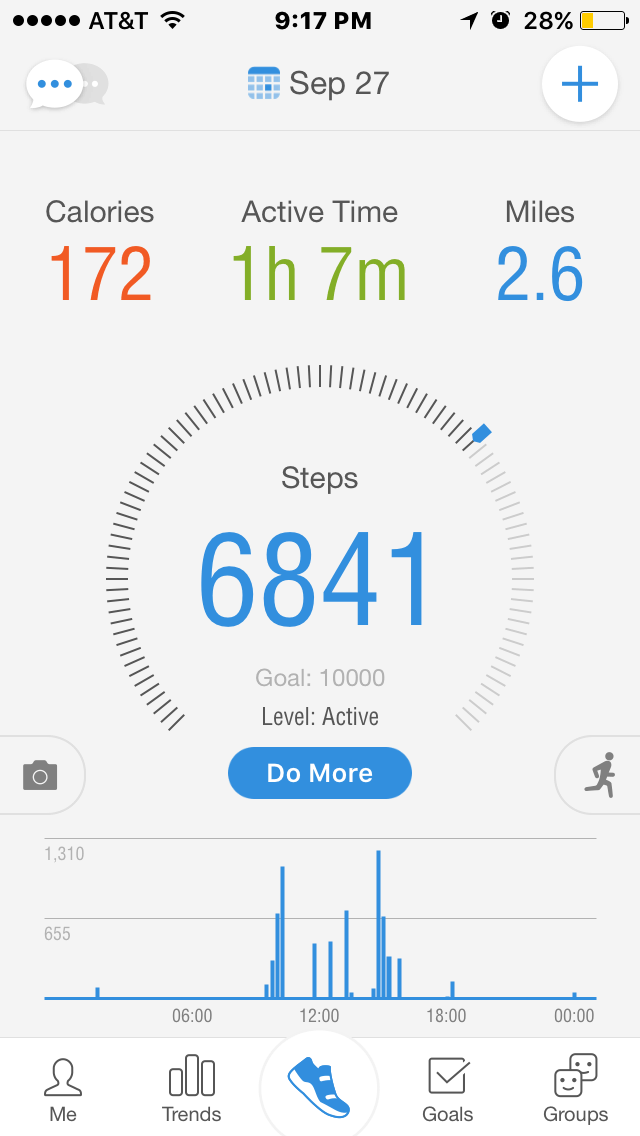
Hello, hello! What time is it? Time to resist the urge to obnoxiously insert link to that infamous High School Musical music video … It’s Experiment Chronicles time!
If you’re just joining us, I’m the resident guinea pig of College Fashion land. I test out different productivity methods, new ways to insert more play into your life (because play is good), and try to be a healthier person.
Table of Contents
What’s up this week?
-Consolidating gamification and to-do list strategies
-Combining KISS (Keep It Simple, Stupid) exercise and lazy meditation
Work: 1-3-5 To-Do Lists

Set-Up
The 1-3-5 To-Do List is a format created by Alex Cavoulacos, The Muse’s Founder and COO. Essentially, you limit your daily to-do list to 9 items in order to accomplish:
- 1 big thing
- 3 medium things
- 5 small things
If you liked the idea of gamifying your schoolwork but found the method too complicated, doing 1-3-5 combined with rewards is a simplified version.
Daily points are still involved. Backed by the idea behind Habit Judo and the psychology behind random variable reinforcement, I used a random number generator to spit out a number between (1-9, 10-90) depending on how many tasks I’d accomplished that day.
EX: I finish 7 tasks then the random generator would spit a number between 7-70.
I’d add those daily points on top of my semester cumulative total, goal being to reach 10,000 points by the end of the semester. Like Habit Judo’s judo belt system where you level up at certain point levels, I gave myself target levels to hit every 1,000 points. I didn’t reward myself for every level I hit, unlike my previous gamification system (see: Play below). For fun, I gave the levels names correlating to shows/books I enjoy (e.g. Level 4: huntress to correspond with RWBY).
Bonus points: Give yourself a productivity score (1-10) for each day and write down why. For instance, you give yourself a 9/10 because you finished all your tasks but went to sleep at 5AM. Or you give yourself a 5/10 for only finishing small tasks but at least you got some essential chores/errands done. The beauty of 1-3-5 is that you will always get something important done no matter how small.
Results
10 days later, I had finished:
- 8 big tasks (80% success rate)
- 24 medium tasks (80% success rate)
- 34 small tasks (68% success rate)
Total cumulative points: 1,115 points -> Level 1: Beginner
Pros
I am fond of this method because it’s so flexible. I can throw in anything (work tasks, school stuff, personal things, chores/errands, etc.) if I consider it a priority. I can tackle the list in any order I want – build up with a small task or jump in with a big/medium task. I can leave a slot blank to fill in later. I can make my list the night before or the day of.
I’m not limited to anything, including the size or task definition. Sometimes the tasks were big because of time length, amount of dread, or the consequences of pushing it off.
All my tasks started with a verb (Read Management CH 1 or Wake up at 6a.m.) but weren’t restricted. Sometimes a task was a scheduled event if it wasn’t recurring or it was time-consuming and/or particularly important to me that day.
Creating a daily 1-3-5 list also helped with time/energy management. You know straight off the bat that you have tasks that are going to take up a lot of time and energy and must carefully partition your resources per task. Not to mention, this method and rewards = important things done + relaxation.
I genuinely prefer this to-do list method over anything else I’ve tried in the past. It focuses on what I think is important. It’s easy to start on because there are only 9 tasks I need to do. It builds ‘resilience.” I can prepare myself (emotionally, physically, mentally) to begin a task because the 1-3-5 stratification helps me figure out how much I need to psych myself up for each item.
Cons
This method is great for day-to-day planning, but not so much for long-term planning. Therefore, to expand the system I’d suggest making lists of goals to draw from. Maybe a list of goals for each life balance category, or you could try the popular 101 New Things in 1001 Days challenge. For schoolwork specifically, I’d suggest using an assignment list.
You still have to a keep a schedule with 1-3-5 (I prefer Google Calendar) for all your recurring/special meetings, events, classes, and major deadlines. This isn’t a major con, just something to consider.
Play: Rewards for 1-3-5 To-Do Lists

Set-Up
As excited as I was about creating a painless gamified to-do list, I was really reluctant to part with the rewards that I’d get at certain point levels. Then I realized: Duh! I can just make rewards a daily thing.
I was originally going to give myself a reward after each task but a side rewards list (see: Work picture) was more practical. Sometimes tasks go bam-bam-bam and you don’t have time to reward yourself after each one. Plus, a string of rewards is always fun. A side rewards list also lets you cherry pick the order so it feels less like an added chore.
I gave myself leeway when it came to types of rewards. Sometimes the reward was pure leisure. Sometimes it was self care-oriented if I knew a 1-3-5 task was whew-done-worthy or if I hadn’t been healthy for the last few days while I was getting things done. Sometimes it was a reward task that was productive but still rewarding.
Results
My overall reaction to this experiment? A lot of heart-eye emojis. It’s fantastic.
This system is just as flexible as 1-3-5 is in terms of how I can define a reward, so I’m not just constantly gorging on mindless entertainment or food. It’s good motivation to finish tasks. It lets me save some space in my 1-3-5 so I’m not putting reward-tasks or self-care activities in my list unless it’s really necessary (i.e. go to sleep early goes onto 1-3-5 instead of the reward list if I haven’t slept more than 10 hours in 2 days, etc.)
Rest: 10,000 Steps

Set-Up
I saw a Buzzfeed Life/Change video about how a group of people tested out walking 10,000 steps daily for a month. It’s like drinking enough water: Sounds easy enough but turns out people are terrible at remembering to actually do it. I liked how “concrete” the number was and how it could be easily quantified with a pedometer (app because hi, technology). After all, that’s how SMART goals work. Specific, measurable, attainable, realistic, and timely. It seemed like a small thing I could do every day for my health.
After reading an article on Lifehack about how walking counts as meditation, I was sold. I can’t seem to wrap my head around meditation and this seemed KISS enough. I downloaded the nifty Pacer pedometer app and was on my way. I wanted to track how much I walked on a daily basis. 280,000 steps in 28 days. How hard could it be?
Results
Pacer calculates steps walked, active time spent walking, and miles walked.
Over 28 days, I walked a total of:
- 921 minutes = 15 hours (48 mins/d median)
- 36 miles (1.6 mi/d median)
- 94,613 steps (4,290 steps/d median)
The most I walked was 6,841 steps one day. (The numbers should also be taken with a grain of salt because I didn’t have my phone on me every time I walked.)
On one hand, I’m disappointed I didn’t hit the 10,000 steps/day target. On the other hand, I’m surprised that I walk so much given that I’m a commuter surrounded by urban sprawl. The 15 hours, 36 miles, and 95k steps were all non-dedicated exercise. Even on the days I didn’t exercise, I was still getting in enough physical movement to be classified as somebody who is “lightly active.”
I knew 10,000 steps was in the ballpark of 5 miles and 85 minutes so that pushed me to use the stairs more and intentionally park further away to get in more steps.
I noticed that the days I walked the least were when I locked myself away to do work. I did notice I was a lot more chill on the days I got more steps in. Whether because of dopamine or less of a workload, I’ll take it.
Tracking helps with future decisions. Having my baseline floating around my head helps me hit future goals. I will add “walking” as a reward or 1-3-5 task on heavy-workload days and set myself a new target goal of a consistent 5,000 steps/day. That shouldn’t be too much of stretch beyond what I’ve already been doing, then I’ll bump it up to 10k/day.
What have you been experimenting with?
Have you ever done the 1-3-5 list before? Would you try it out? What’s your favorite to-do list strategy? Do you reward yourself for finishing tasks? What are your favorite yay-I’m-done rewards? Let us know in the comments!
